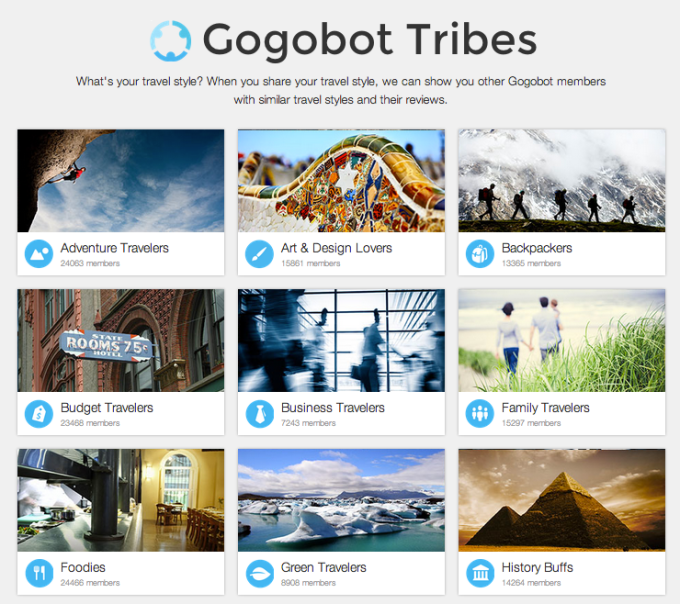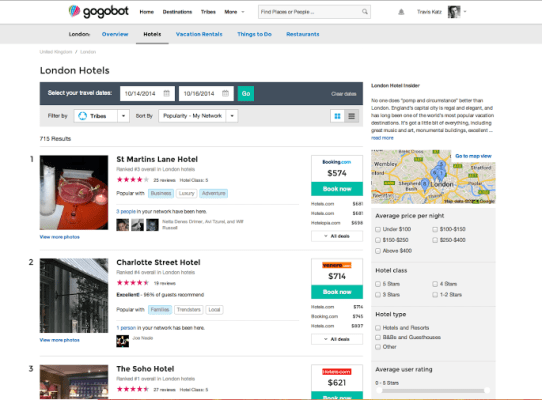Gogobot launched in 2010 in the early stage of a wave of new interest in the social travel space, as a glut of new startups promised to as a new generation of companies promised to transform stodgy old travel with the magic of the social graph. Some of those players built products on top of Facebook, growing quickly thanks to the instant-scale of Facebook’s platform. However, it was a dangerous game, as Facebook could shut off access to its social graph, platform and data, and Gogobot knew that it couldn’t rely on the social network to build a business, Gogobot founder Travis Katz tells us.
While the platform remains one of the most popular destinations if you’re looking for socially-powered recommendations or reviews of travel destinations, hotels and activities, Gogobot is looking to become more of an end-to-end solution or travel concierge. People are still going to dozens of sites while planning vacations and travel, Katz says, so Gogobot wants to expand its utility with tools that will help eliminate some of the fragmented search problem.
To do that, on top of the ability to peruse its 650K reviews and four million photos, Gogobot has added features like the ability to book a hotel on the fly (on web and mobile), view realtime hotel pricing and availability, user rankings and hotel class. The startup has also been looking for ways to deepen its utility as a travel search mechanism, like filtering results based on where your friends have been, what hotels are available for “x” price and so on.
The Gogobot CEO tells us that 15 million people used the platform to plan their travels in 2013, and as the network grows, the company continues to step into Kayak’s territory, especially where search is concerned. Today, for example, the startup added metasearch functionality to its social travel platform, giving travelers a way to search for and find hotel and accommodation deals from a range of booking services, including Booking.com, Hotels.com and Travelocity. The launch comes on top of Gogobot’s recently launched “Tribes” vertical, which allows users to search for destinations or different experiences according to their style and preferences of choice.

Tribes leverages the millions of data points Gogobot has collected over the last three years on trends and styles among different demographics of travelers to help those researching a trip find one that matches their particular preference. Travelers can search through the vertical’s categories, like “Adventure Travelers,” “Art And Design Lovers,” “Foodies,” or “Budget Travelers,” for example, to find the “best place to picnic in Paris,” and so on.
With Tribes and its new metasearch feature, following in the wake of Kayak, Gogobot wants to become a one-stop shop for travelers to research and book travel and streamline the trip planning process. For instance, as nearly 5 percent of travelers visit more than 150 sites before securing a room on a hotel’s website, metasearch aims to narrow that process down.
Now, when users search for hotels in Las Vegas, Gogobot will show prices from over 30 different booking sites, giving users optionality while allowing them to get smart recommendations and a realtime look into how pricing compares between sites. This is especially relevant on mobile, as travel platforms are now seeing an increasing amount of traffic derived from users searching for flights, hotels and restaurants from their mobile devices. Over 40 percent of Gogobot’s traffic now comes from its mobile site and native apps, for example.

However, with travel being a highly-regulated industry and competition quickly increasing for viewers’ attention — not to mention that people usually only search widely for travel (other than business) a few times a year — it can be tough to make money. This, in part, explains why so many companies have turned to utilities like hotel search and booking, an area where it’s a bit easier to make money.
To this point, Gogobot has the advantage of the fact that 93 percent of its traffic is organic, Katz says, which means the vast majority isn’t paid and allows the company to keep its burn rate low. In addition, the CEO tells us that leads to its hotel booking partners has grown 10-fold over the last 12 months and revenue is beginning to pick up as a result.
Ultimately, metasearch and hotel price comparison can only go so far. But, with over 650K reviews, Gogobot is starting to boost its likelihood of becoming the place that people researching destinations for their next vacation or getaway turn to for advice — and to book.
For more, find Gogobot at home here.
